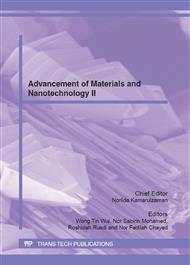p.321
p.325
p.330
p.335
p.342
p.348
p.355
p.359
p.367
Water Absorption and Modification of Kenaf and Flax Fibres
Abstract:
The experimental work for this project involved several strands; to study the water absorption characteristic of kenaf and flax in composites, to investigate the influence of fibre types on water absorption, and finally to investigate the influence of chemical treatment on water absorption. Hydrophilic character of natural fibres is responsible for the water absorption in the composites. Water absorption of kenaf and flax reinforced polyester composites was occurred via fibres lumen. Mechanical properties are affected by water absorption. After water absorption test, the specimens present poor mechanical properties such as lower value of flexural strength and flexural modulus. The matrix structure was also affected by water absorption by processes such as chain orientation and shrinkage. It was found that the different fibre types had influenced the different percentage of water absorption in composite. It seems that the compatibilization between fibres and matrix has influenced the water absorption of fibres. Acetylation of kenaf and flax fibres has reduced the hygroscopic nature of natural fibres and increased the dimensional stability of composites. The flexural strength properties of acetylated fibres were higher than untreated fibres composites.
Info:
Periodical:
Pages:
342-347
Citation:
Online since:
July 2012
Authors:
Keywords:
Price:
Сopyright:
© 2012 Trans Tech Publications Ltd. All Rights Reserved
Share:
Citation:


